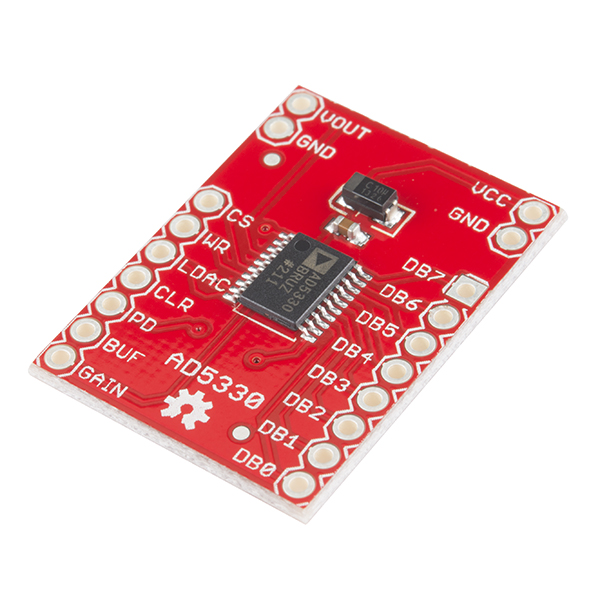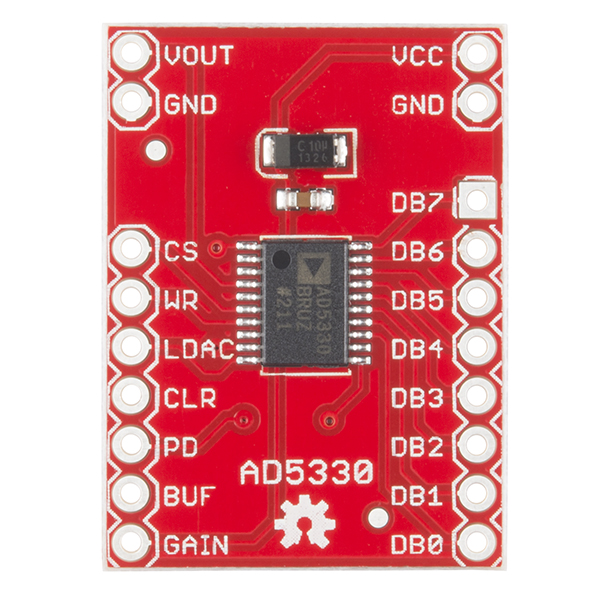SparkFun Parallel DAC Breakout - AD5330 (8-Bit)
This is a simple breakout board for Analog Device's AD5330 8-bit digital-to-analog converter (DAC). The AD5330 has a parallel interface, and can operate from a 2.5 to 5.5V supply consuming just 115uA (at 3V).
The DB0-7 pins, the parallel data inputs, are used to configure the analog output voltage. CS selects the device, and data is loaded into the input registers on the rising edge of WR. The GAIN pin allows the output range to be set at either 0V to VCC or 0V to 2VCC.
Input data to the AD5330 is double-buffered, allowing simultaneous update of multiple DACs in a system using the LDAC pin. An asynchronous CLR input resets the contents of the input register and the DAC register to all zeros. The AD5330 also incorporates a power-on reset circuit that ensures that the DAC output powers on to 0V and remains there until valid data is written to the device.
This breadboard friendly board breaks out every necessary pin of the AD5330 to 0.1" spaced headers. The board includes a decoupling capacitor, but does not do any voltage regulation; voltage supplied to the board should be within the specified range.
SparkFun Parallel DAC Breakout - AD5330 (8-Bit) Product Help and Resources
Core Skill: Soldering
This skill defines how difficult the soldering is on a particular product. It might be a couple simple solder joints, or require special reflow tools.
Skill Level: Noob - Some basic soldering is required, but it is limited to a just a few pins, basic through-hole soldering, and couple (if any) polarized components. A basic soldering iron is all you should need.
See all skill levels
Core Skill: Programming
If a board needs code or communicates somehow, you're going to need to know how to program or interface with it. The programming skill is all about communication and code.
Skill Level: Competent - The toolchain for programming is a bit more complex and will examples may not be explicitly provided for you. You will be required to have a fundamental knowledge of programming and be required to provide your own code. You may need to modify existing libraries or code to work with your specific hardware. Sensor and hardware interfaces will be SPI or I2C.
See all skill levels
Core Skill: Electrical Prototyping
If it requires power, you need to know how much, what all the pins do, and how to hook it up. You may need to reference datasheets, schematics, and know the ins and outs of electronics.
Skill Level: Noob - You don't need to reference a datasheet, but you will need to know basic power requirements.
See all skill levels
Comments
Looking for answers to technical questions?
We welcome your comments and suggestions below. However, if you are looking for solutions to technical questions please see our Technical Assistance page.
Customer Reviews
3 out of 5
Based on 1 ratings:
1 of 1 found this helpful:
board is good
Although the dac distorts severely at 20khz and above update rate...keeps a simple square wave at 11 khz...this is not a high speed dac...not even suitable for audio at 20khz sample rate





If you guys added a V-REG this would be awesome!
Presumably whatever microcontroller you have driving this already has a source of regulated 3V3 or 5V?
But if it had a V-REG you wouldn't have to worry about higher voltage.